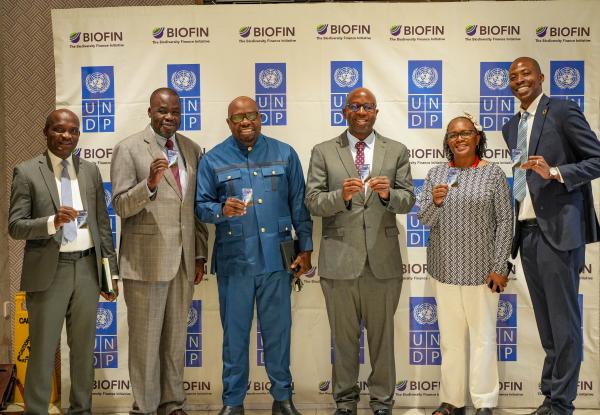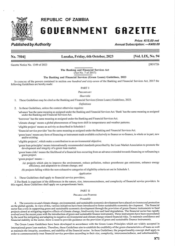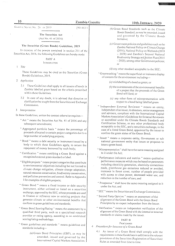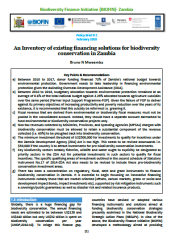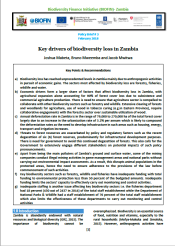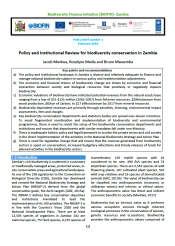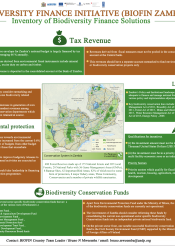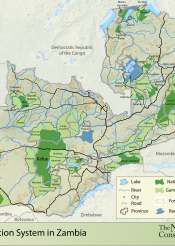Zambia
BIOFIN Zambia commenced its operations in 2015. It has been anchored in the Ministry of Lands and Natural Resources under the Department of Climate Change and Natural Resources.
Zambia is endowed with an abundance of natural resources and a rich biological diversity. Like other developing countries, Zambia is highly dependent on the exploitation of biological resources for the livelihood of the majority of its people especially those living in rural areas.
The importance of biodiversity for Zambia lies mainly in its contribution to the provision of ecosystem goods and services for national economic development and livelihoods. At the ecosystem level, forests, agro-ecosystems and wetlands can be distinguished as the key ecosystem components that have a relatively greater bearing on the country’s natural system integrity upon which the national economy and the livelihoods of the population depend.
The network of Zambia’s statutory protected areas (PA) is composed of over 63,580 km2 in 20 National Parks (NPs), about 167,557 km2 in 36 Game Management Areas (GMAs) and about 74,361 km2 in 490 Forest Reserves (FRs). Zambia has Eight Wetlands of International Importance which include, the Kafue Flats (Lochnivar and Blue Lagoon National Parks) Bangweulu Swamps (Chikuni), Lukanga Swamps, Busanga, Lake Tanganyika,, Luangwa Floodplains, Lukanga swamps, Barotse floodplain) listed under the Ramsar Convention. These wetlands are habitats of several important fauna and flora species including some endemic and endangered species. The estimates of mammal diversity in Zambia is around 224 species. The REMNPAS (2010) on the other hand reports that approximately 43 species of large mammals are important; firstly on account of the potential income that can be generated from their use in photographic and consumptive tourism, secondly, their contribution to local household economies, as a source of protein and as a source of income through illegal market structures, and thirdly, their aesthetical appreciation by the global community including their existence value. According to the 2014 Red List of Threatened Species, over 28 animal species and subspecies are considered as threatened, endangered or vulnerable in Zambia.
- Developed the country strategy plan which is focused on mainstreaming green finance into Zambia’s financial sector, with green bond guidelines and listing rules being gazzetted .
- Formed a green finance mainstreaming working group with the finance sector regulators notably the Securities and exchange Commission (SEC), the Bank of Zambia (BOZ) and the Pensions and Insurance Authority (PIA). This is the main vehicle for the mainstreaming of green finance, including biodiversity finance, into Zambia’s financial sector.
2 December 2025
1. Technical Assistance for Green Bond Market Development and Transaction Preparation
The main objective of this finance solution is to develop Zambia’s green bond market with a view to have a some of the proceeds of green bonds go towards financing biodiversity conservation initiatives. Having finalized the development of the green bond guidelines and listing rules which have since been gazzeted, the next steps are mainly capacity building of the Securities and Exchange Commission who will be approving green bond applications as well as the newly formed Green Finance Mainstreaming Working Group in terms of reviewing proposals, development of customized standards and taxonomies for specific sectors as well as provision of TA support in green bond structuring support to potential issuers.
2. Mainstreaming biodiversity in the Green Finance Policy and implementation plan for the Financial Sector
The main objective of this finance solution is to mainstream biodiversity conservation, climate change and land degradation ethos into the soon to be developed Green Finance Policy for the financial sector. The development of the Green Finance Policy for the financial sector will help to provide a platform to mainstream biodiversity into the credit policies and other financial sector products especially in terms of credit allocation across other sectors.
3. Developing a Green Finance Tagging/reporting System for the Financial Sector
The main objective of this finance solution is to mainstream biodiversity conservation, climate change and land degradation markers into the reporting systems of the financial sector so that it is easier to track the flow of green finance in these sectors.
The expected result is twofold (i) Enable the tracking of green finance through the financial sector (ii) Once tracking commences, it will be easier to make decisions to lobby for an increased allocation of financial products for the green sector. At present, it is not known how much the financial sector contributes in terms of green finance which makes it difficult to make policy decisions.
The PIR has been completed and ready for publishing. The process included a review of the policies, legal instruments and institutional set ups for biodiversity financing. Through the PIR, Zambia did identify a number of potential solutions some of which found their way into the BFP.


